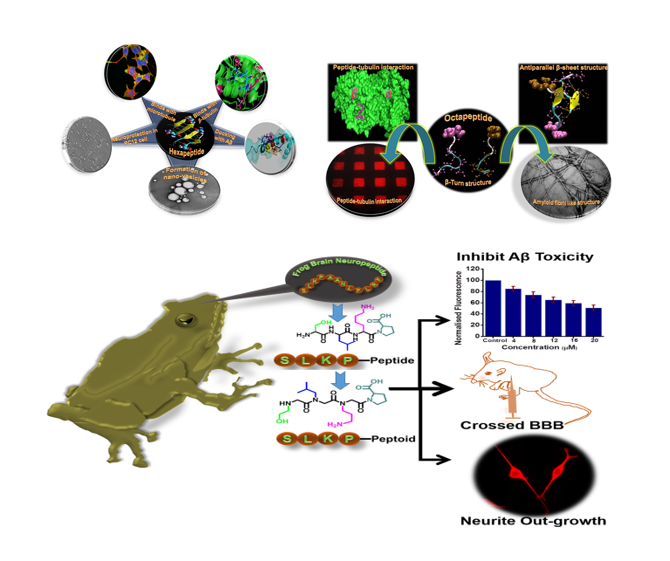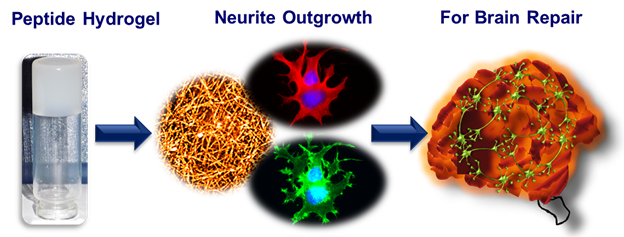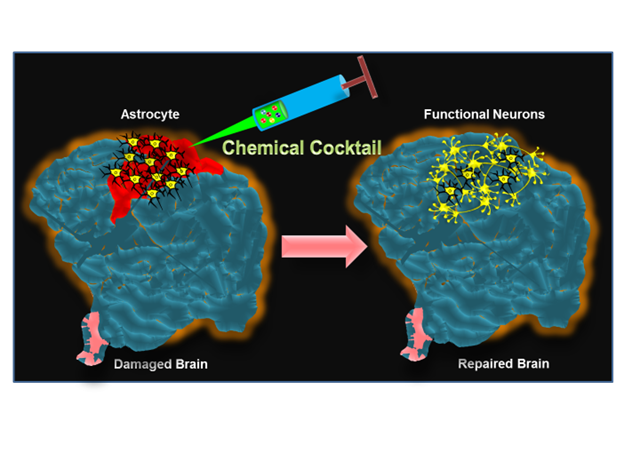Chemical Neuroscience:
- Small molecules and peptides for neurogenesis
- Peptides and peptoids for neuroprotection
- Neuroprotective hydrogel for traumatic brain injury (TBI) and neuron cell transplantation
- Therapeutics for Alzheimer's Diseases (AD)
Highlight of recent progress in these areas as follows:
- In the area of chemical neuroscience, we have computationally designed an interesting library consisting of ~500 peptides. From this library, we screened around 20 peptides using computational and various in vitro experiments. Currently, we found four peptides with excellent neuroprotective activities; we have filed for US patent for one of the peptides. Other peptides are in the process of patenting. Interestingly, in order to overcome the potential proteolytic degradation of peptides in vivo, we have designed peptoids based on these lead peptides. In fact, these lead peptoids are showing excellent neuroprotection (Unpublished Data). Further, we are now designing small molecules from those lead peptides and peptoids. Overall, in this chemical neuroscience area, we have already few lead molecules, having high translational potential; some of the results have already been published in high visibility journals. [Ref: Mondal et al., ACS Chem. Neurosci., 2018, Pal et al. Chem. Sci. 2017, Biswas et al., ACS Chem Neuroscience, 2015; Biswas et al., Chem. Commun. 2014, Ghosh et al., US patent filed; Ghosh et al., Indian Patent Filed; Saha et al., Chem. Commun. 2013, Saha et al., Chem. Commun. 2015].

- Recently, we developed an easy and efficient strategy to culture cortical and hippocampal primary neurons from the E14-E16 embryo of Sprague−Dawley rat. This generates spontaneous neurospheres within 6-7 days of primary neuron culture of E14-E16 embryo. It further proliferates and forms radial glia-like structures, which are known to be the primary neural progenitor cells that differentiate into neurons, astrocytes, and oligodendrocytes. Interestingly, neurospheres lead to the formation of large projection neurons and radial glia, which mimic the early stage of cortical development in an in vivo system. Overall, this new, facile, strategic mixed primary neuron culture method offers a potential platform for understanding the effect of neurochemical modulators, which has tremendous future implications in the screening of neurotherapeutics. This work has already published in the ACS Chemical Neuroscience, 2018 and highlighted in the front cover of the issue..

- In the area of traumatic brain injury, we developed novel neuro-compatible peptide based hydrogel, which contain microtubule stabilizing short peptide. This hydrogel shows strong three dimensional cross-linked fibrillary networks, which can capture water molecules. Interestingly, this hydrogel served as excellent biocompatible soft-materials for 2D and 3D (neuro-sphere) neuron cell culture and maintain key cytoskeleton filaments (microtubule and actin) healthy. Remarkably, it was observed that this hydrogel slowly enzymatically degrades and release neuroprotective peptide, which promotes neurite outgrowth of neuron cell. This is the first hydrogel, which auto-releases neuroprotecting peptide. Thus, this novel hydrogel can be used for neuronal cell transplantation for repairing brain damages. This work has published in Adak et al., ACS Applied Materials and Interface, 2017.

- Recently, we have developed another injectable hydrogel with acetylcholine-functionalized graphene oxide and poly (acrylic acid). Results revealed that this hydrogel is non-cytotoxic, promotes neurite outgrowth, stabilizes microtubule networks, and enhances the expression of some key neural markers in rat cortical primary neurons. Further, this hydrogel exhibits significant potential in neuro-regeneration and also promotes fast recovery of the sham injured mice brain. Moreover, we found significant enhancement of reactive astrocytes in the hippocampal dentate gyrus region of the sham injured brain, indicating its excellent potential in neural repair of the damaged brain. Finally, above results clearly indicate that this neuro-regenerative hydrogel is highly capable of maintaining the cholinergic balance through local release of acetylcholine in the injured brain, which is crucial for brain repair. This work has published in the ACS Chemical Neuroscience, 2018.

- Our group also working on chemical reprogramming to transform glial cells (astrocyte) to functional neurons for repairing the damages in brain. Das et. al. ACS Chemical Neuroscience 2018.
